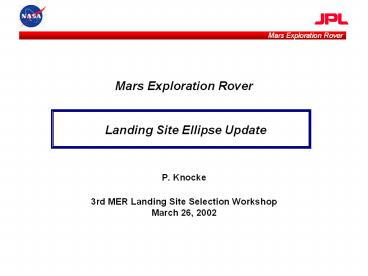Mars Exploration Rover Landing Site Ellipse Update - PowerPoint PPT Presentation
Title:
Mars Exploration Rover Landing Site Ellipse Update
Description:
... affect quantity of Doppler & Range tracking available for MER. ... Separation V, HRS venting V. Operational effects: in-flight anomalies, targeting process, ... – PowerPoint PPT presentation
Number of Views:156
Avg rating:3.0/5.0
Title: Mars Exploration Rover Landing Site Ellipse Update
1
Mars Exploration Rover Landing Site Ellipse
Update
- P. Knocke
- 3rd MER Landing Site Selection WorkshopMarch 26,
2002
2
10/2001 Site Ellipse Analyses and Assumptions
- Entry dispersions were for TCM5 at Entry - 2 days
data cutoff at Entry - 2.5 days - Assumes Auto-TCM designed maneuver instead of
library of fixed maneuvers - Approach Nav estimates include ?DOR and
peer-reviewed orbit determination filter inputs - A "no margin" floor capability was established,
then margins were added for Navigation
robustness. - Nav delivery capabilities are strongly dependent
on spacecraft dynamics - ACS events, non-grav acceleration uncertainty,
maneuver execution error - Nav delivery capabilities do not apply in the
event of a thruster failure - Unbalanced turns produce non-zero net ?V from
each ACS event, resulting in degraded
performance. - LARC 6DOF and/or JPL 3DOF Monte Carlo analyses
were performed for all ROTO sites plus Athabasca.
99 landing ellipses were calculated. - Sets of 2000 entry states were provided at
IP85A, TM10A, VM53A, EP55A, IP98B, TM20B, Melas B
Site - B-plane dispersions generated from these data,
plus new nominal entry states, were used to
create approximate dispersed states for Monte
Carlo analyses at the other ROTO sites. - Curve fits based on the ROTO site ellipses were
used to provide approximate landing ellipse
dimensions for the Nadir sites - EDL margins were added to the 99landing ellipses
to account for other potential effects on ellipse
dimensions, including - Sustained winds, additional atmospheric density
dispersions, potential change in target entry
flight path angle, etc.
3
EDL Margins
Total Downtrack EDL Margin is equivalent to an
EFPA error of 0.04 - 0.05 Partial 5 km
Total Downtrack per 0.01 3s EFPA
4
Gusev Example 10/2001 Site Location
Site Ellipse
99 unmargined Ellipse
Monte Carlo Scatter Points
5
Nav Update
- Work done for 10/2001 workshop suggested an
uncertainty i.e. noise of 0.02 in 3s?EFPA
errors, based on effects of minor changes to
analysis ?DOR Doppler/Range scheduling, etc. - Covariance Study comparison with Odyssey approach
reconstruction - Good agreement - no need to change Orbit
Determination filter assumptions - Further refinement of delivery estimates
- Revision of TCM-5 maneuver execution errors 1s
reduced by 1 mm/s MER-A, 2 mm/s MER-B - Latest Delivery estimates are at level of 10/2001
numbers or better - DSN contention during MER approach phase is high,
and may affect quantity of Doppler Range
tracking available for MER.
6
Updated Landing Error Estimates
- Site locations have changed slightly, with
negligible effect on site dimensions - EDL Margins are unchanged
- Likelihood of shallowing the targeted entry
flight path angle is somewhat lower, depending on
results of the parachute deploy strength tests in
May 2002 - Updated landing error ellipses including EDL
margin based on new Nav delivery are slightly
smaller
Estimate based on curve fit from 10/2001 and
other data Based on
POST AEPL Monte Carlos using 2000 entry states
generated 3/1/2002.
7
Melas MER-B Open
Site Ellipse 10/2001 105 km x 20 km, 82 Az
EDL-margined TCM-5 Ellipse, from updated Nav 88
km x 17 km, 83 Az
8
Conclusions
- No change to the Site Ellipse dimensions are
recommended - New Nav estimates improve 3s EFPA error by up to
0.04 - New uncertainties and potential threats are
comparable in magnitude - Analysis "noise" 0.02
- Threat to Doppler/Range tracking schedule
0.03 - Other Issues
- Current analyses assume some ground system
infrastructure performance beyond levels
previously committed to. - e.g. Earth orientation parameters, media
calibrations, etc. - Not currently modeled
- Separation ?V, HRS venting ?V
- Operational effects in-flight anomalies,
targeting process,































